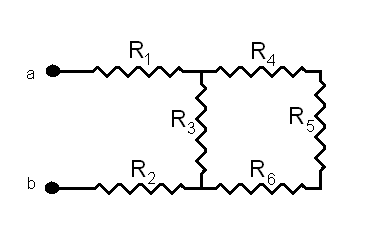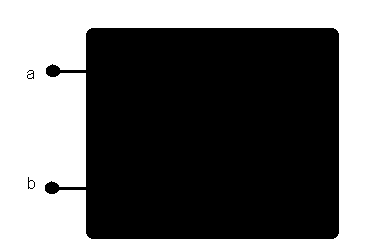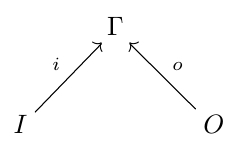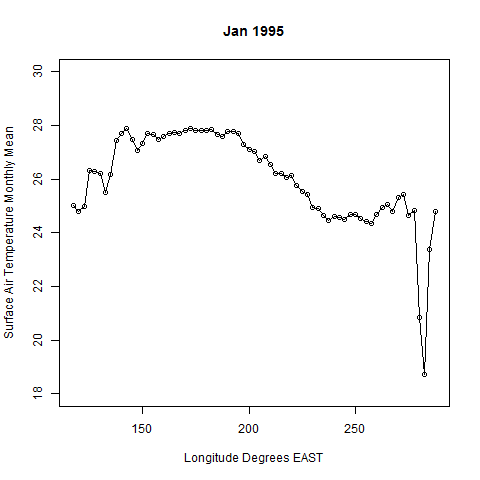John C. Baez's Blog, page 83
October 20, 2014
Network Theory (Part 32)
Okay, today we will look at the ‘black box functor’ for circuits made of resistors. Very roughly, this takes a circuit made of resistors with some inputs and outputs:

and puts a ‘black box’ around it:

forgetting the internal details of the circuit and remembering only how the it behaves as viewed from outside. As viewed from outside, all the circuit does is define a relation between the potentials and currents at the inputs and outputs. We call this relation the circuit’s behavior. Lots of diff...
October 16, 2014
Network Theory Seminar (Part 2)
This time I explain more about how ‘cospans’ represent gadgets with two ends, an input end and an output end:

I describe how to glue such gadgets together by composing cospans. We compose cospans using a category-theoretic construction called a ‘pushout’, so I also explain pushouts. At the end, I explain how this gives us a category where the morphisms are electrical circuits made of resistors, and sketch what we’ll do next: study the behavior of these circuits.
These lecture notes provide extr...
October 13, 2014
El Niño Project (Part 8)
This time I’d like to compare a different paper on climate networks:
• Y. Berezin, A. Gozolchiani, O. Guez and S. Havlin, Stability of climate networks with time, Scientific Reports 2 (2012).
The goal of this paper is to see how stable over time climate networks over time. They divide the world into 9 zones:

For each zone they construct several climate networks. Each one is an array of numbers  , one for each year
, one for each year  and each pair of grid points
and each pair of grid points  in that zone. They call
in that zone. They call  a link strength: it’s a mea...
a link strength: it’s a mea...
Network Theory (Part 31)
Last time we came up with a category of labelled graphs and described circuits as ‘cospans’ in this category.
Cospans may sound scary, but they’re not. A cospan is just a diagram consisting of an object with two morphisms going into it:

We can talk about cospans in any category. A cospan is an abstract way of thinking about a ‘chunk of stuff’  with two ‘ends’
with two ‘ends’  and
and  It could be any sort of stuff: a set, a graph, an electrical circuit, a network of any kind, or even a piece of matter (in some mat...
It could be any sort of stuff: a set, a graph, an electrical circuit, a network of any kind, or even a piece of matter (in some mat...
October 11, 2014
Network Theory Seminar (Part 1)
Check out this video! I start with a quick overview of network theory, and then begin building a category where the morphisms are electrical circuits. These lecture notes provide extra details:
With luck, this video will be the first of a series. I’m giving a seminar on network theory at U.C. Riverside this fall. I’ll start by sketching the results here:
• John Baez and Brendan Fong, A compositional framework for passive linear networks.
But this is a big paper, and I...
October 7, 2014
The Large-Number Limit for Reaction Networks (Part 3)
joint with Arjun Jain
We used to talk about reaction networks quite a lot here. When Arjun Jain was visiting the CQT, we made a lot of progress understanding how the master equation reduces to the rate equation in the limit where there are very large numbers of things of each kind. But we never told you the end of the story, and by now it’s been such a long time that you may need a reminder of some basic facts!
So…
The rate equation treats the number of things of each kind as continuous—a nonneg...
October 2, 2014
Network Theory (Part 30)
The network theory series is back! You may have thought it died out, but in fact it’s just getting started. Over the last year my grad students have made huge strides in working out the math of networks. Now it’s time to explain what they’ve done.
In the last three episodes I explained how electrical circuits made of resistors, inductors and capacitors are a great metaphor for many kinds of complex systems made of interacting parts. And it’s not just a metaphor; there are mathematically rigoro...
September 27, 2014
Network Theory News

You may be wondering, somewhere deep in the back of your mind, what happened to the Network Theory series on this blog. It’s nowhere near done! I plan revive it soon, since soon I’ll be teaching a seminar on network theory at U.C. Riverside. It will start in October and go on at least until the end of March.
Here’s a version of the advertisement I sent to the math grad students:
Network Theory Seminar
I’ll be running a seminar on Network Theory on Mondays from 3:10 to 4:30 pm in Surge 268 star...
September 15, 2014
Exploring Climate Data (Part 2)
guest post by Blake Pollard

I have been learning to make animations using R. This is an animation of the profile of the surface air temperature at the equator. So, the x axis here is the longitude, approximately from 120° E to 280° E. I pulled the data from the region that Graham Jones specified in his code on github: it’s equatorial line in the region that Ludescher et al. used:

For this animation I tried to show the 1997-1998 El Niño. Typically the Pacific is much cooler near South America, d...
September 7, 2014
The Logic of Real and Complex Numbers
I’ve always liked logic. I studied it a bunch in high school and college. Nowadays it’s a kind of hobby. I turn to it for relief sometimes when I become frustrated trying to figure out what I can do about global warming. Lately I’ve been digging a bit deeper into the logic behind the real and complex numbers. And I’m teaching a graduate course on real analysis this fall, so I actually have a slight excuse for doing this.
There’s something about logic that’s both fascinated and terrified me eve...
John C. Baez's Blog
- John C. Baez's profile
- 29 followers



